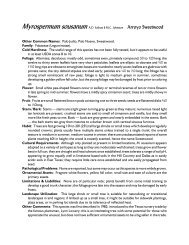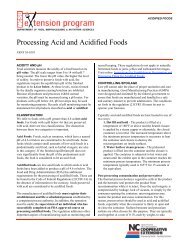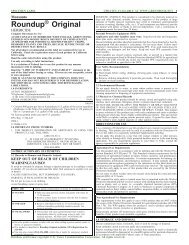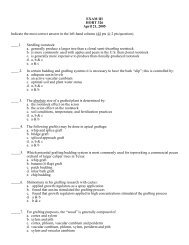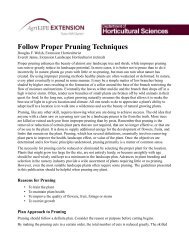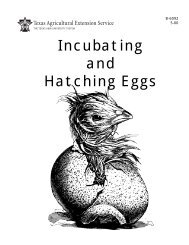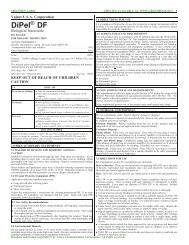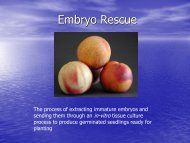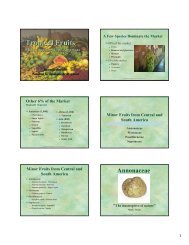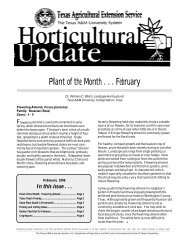Guide to PAS 2050 How to assess the carbon ... - Aggie Horticulture
Guide to PAS 2050 How to assess the carbon ... - Aggie Horticulture
Guide to PAS 2050 How to assess the carbon ... - Aggie Horticulture
You also want an ePaper? Increase the reach of your titles
YUMPU automatically turns print PDFs into web optimized ePapers that Google loves.
6<br />
Section I: Start-up<br />
Who should be involved?<br />
In a larger organisation internal participants could<br />
include, where applicable, representatives from:<br />
• Senior management<br />
• Environment/corporate social responsibility (CSR)<br />
• Marketing/communications<br />
• Production<br />
• Procurement/supply chain<br />
• Logistics<br />
• Energy<br />
• Finance/performance management<br />
• Analysts1 who will lead <strong>the</strong> <strong>carbon</strong> footprint<br />
calculations<br />
1<br />
Many companies hire third-party consultants <strong>to</strong> perform <strong>the</strong><br />
product <strong>carbon</strong> footprinting analysis. The decision depends on<br />
weighing internal resource availability and expertise against <strong>the</strong><br />
costs of an external provider.<br />
It is useful <strong>to</strong> assemble this team for a series of<br />
introduc<strong>to</strong>ry and scoping workshops <strong>to</strong> discuss <strong>the</strong>se<br />
and o<strong>the</strong>r start-up issues as described below.<br />
Key considerations during start-up phase<br />
• Why product <strong>carbon</strong> footprinting? What are <strong>the</strong><br />
objectives and expected outcomes?<br />
• Based on <strong>the</strong>se objectives, what criteria should be<br />
set for product selection?<br />
• What products could meet those criteria?<br />
• Who are <strong>the</strong> key supplier contacts?<br />
• What resources and budget can be given <strong>to</strong> <strong>the</strong><br />
project?<br />
– e.g. external consultants vs. in-house resources<br />
and expertise<br />
• What governance/decision making structure will<br />
guide <strong>the</strong> project?<br />
• <strong>How</strong> long will it take?<br />
• Who is responsible for what, and what will <strong>the</strong>y<br />
deliver?<br />
Product <strong>carbon</strong> footprinting does not require a fulltime<br />
commitment from all stakeholders, but ra<strong>the</strong>r:<br />
• initial agreement on <strong>the</strong> objectives,<br />
• input throughout <strong>the</strong> process (e.g. help with data<br />
collection), and<br />
• discussion of results and next steps<br />
The level of commitment depends on <strong>the</strong> individual’s<br />
role and <strong>the</strong> complexity and/or number of products<br />
selected for <strong>carbon</strong> footprinting.<br />
Agreeing <strong>the</strong> objectives will help determine <strong>the</strong> size of<br />
<strong>the</strong> ongoing project team. If <strong>the</strong> goal is <strong>to</strong> test <strong>the</strong><br />
method on one product but eventually roll it out <strong>to</strong><br />
o<strong>the</strong>rs, <strong>the</strong>n it may be more effective <strong>to</strong> involve a wider<br />
set of people across <strong>the</strong> organisation – and supply<br />
chain – from <strong>the</strong> beginning. Similarly, if more than one<br />
product is <strong>to</strong> be tested this may impact on how <strong>the</strong><br />
data is collected and formatted. It could be prudent <strong>to</strong><br />
standardise your data collection methods and analysis<br />
in order <strong>to</strong> allow consistency in <strong>the</strong> way you present<br />
results.<br />
Choosing products<br />
When choosing products <strong>to</strong> footprint, it helps <strong>to</strong> set<br />
overarching criteria based on goals for <strong>the</strong> project,<br />
and <strong>the</strong>n <strong>to</strong> identify which products best meet those<br />
criteria. Product selection criteria should fall directly<br />
from <strong>the</strong> objectives agreed at <strong>the</strong> beginning of <strong>the</strong><br />
project, and are a key component of defining <strong>the</strong><br />
scope – how many products, types of product, different<br />
sizes of product, etc.<br />
Key questions <strong>to</strong> consider when selecting products<br />
include:<br />
• Which products are likely <strong>to</strong> yield <strong>the</strong> largest<br />
emission reduction opportunities?<br />
• Which comparisons are most relevant <strong>to</strong> <strong>the</strong><br />
company’s GHG reduction strategy? For example,<br />
comparisons across:<br />
– Product specifications<br />
– Manufacturing processes





